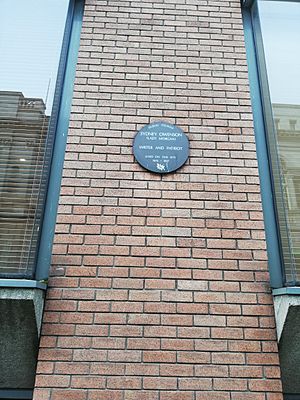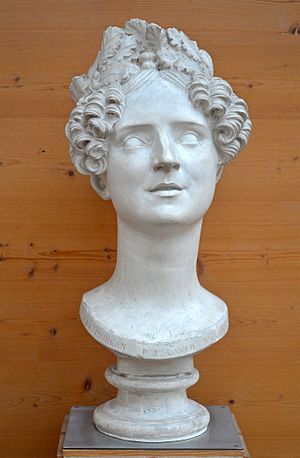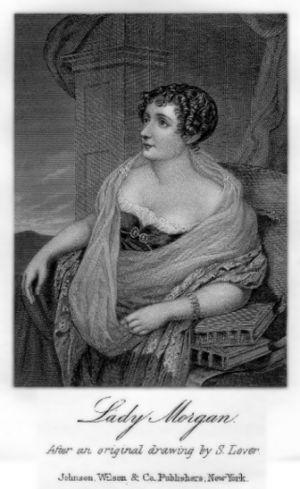Sydney, Lady Morgan facts for kids
Quick facts for kids
Sydney, Lady Morgan
|
|
|---|---|

Portrait by René Théodore Berthon
|
|
| Born | Sydney Owenson 25 December 1781 (?) Either Dublin, Ireland or the Irish Sea |
| Died | 14 April 1859 (aged about 78) London, United Kingdom |
| Resting place | Brompton Cemetery |
| Pen name | Glorvina |
| Occupation | Novelist, governess |
| Language | English |
| Nationality | Irish, British |
| Period | 1804–59 |
| Notable works | The Wild Irish Girl (1806) |
| Spouse | Thomas Charles Morgan (m. 1812) |
Sydney, Lady Morgan (born Sydney Owenson; December 25, 1781? – April 14, 1859) was an Irish writer. She is most famous for her book The Wild Irish Girl (1806). This book was a romantic story with strong feelings about politics and her home country. Some people even say it was "proto-feminist," meaning it showed early ideas about women's rights.
Lady Morgan's writings, including her travel books about Europe, often caused arguments and were sometimes banned. Famous writers like Percy Bysshe Shelley and Lord Byron even defended her work.
Early Life
Sydney Owenson was the daughter of Robert Owenson and Jane Hill. Her father, Robert, was an Irish Catholic and a funny actor. He grew up in London, England. There, he met and married Jane Hill, whose family was Protestant and from Shrewsbury.
In 1776, Robert and Jane moved back to Ireland. They lived in Dublin, and Robert worked as an actor in different theaters. Sydney was born around 1778 and was named after her grandmother. We don't know her exact birth date because Sydney liked to keep her age a secret. She often said she was born on December 25, 1785. Even on her death certificate, her age was listed as "about 80 years."
Sydney spent her early childhood in Dublin with her mother and sister, Olivia. Her mother taught her mostly at home. She also had a young tutor named Thomas Dermody, a very smart boy her father had helped.
In 1789, when Sydney was about ten, her mother died. Her father then sent Sydney and Olivia to private schools. Sydney studied for three years at a school in Clontarf. After that, she went to another school in Dublin. When she finished school, Sydney moved with her father to Sligo.
Around 1798, her family had money problems. Sydney had to leave home to find work. She became a governess (a teacher who lives with a family) for the Featherstone family at Bracklyn Castle. There, she loved to read, became a great talker, and enjoyed singing and dancing. This is also when she started writing.
Career as a Writer
Lady Morgan was one of the most talked-about writers of her time. She started her career by writing poems when she was very young. She also collected Irish songs and wrote new words for them. This became a popular trend, later made even more famous by Thomas Moore.
Her first novel, St. Clair (1804), was about a bad marriage and sad love. It also showed her love for nature. This book quickly got attention. Another novel, The Novice of St. Dominick (1806), was also praised for its creative ideas and descriptions.
The book that made her famous and caused a lot of discussion was The Wild Irish Girl (1806). In this book, she strongly supported her home country, Ireland. She wrote about the beautiful Irish scenery, its rich natural resources, and its old traditions. The main character, Glorvina, was smart and strong. Because of this, the book is seen as "proto-feminist." People who supported the Catholic faith and Liberal ideas often called her Gloria or Glorvina.
She continued to write many books. Patriotic Sketches and Metrical Fragments came out in 1807. In 1811, she published The Missionary: An Indian Tale. Percy Bysshe Shelley really liked The Missionary.
In 1812, Miss Owenson married Sir Thomas Charles Morgan, a philosopher and surgeon. She had been encouraged to marry him by Lady Abercorn, whose household she had joined. Even after marriage, she kept writing many books.
In 1814, she wrote her best novel, O'Donnell. She was very good at describing the lives of poorer people, which she knew well. Her detailed book (1817) about France after the Bourbon kings returned to power was strongly attacked by John Wilson Croker. He accused her of being a rebel and telling lies. He also said her heroines were not acting like proper women. Lady Morgan got her revenge in her novel Florence Macarthy (1818). In this book, she cleverly made fun of a reviewer like Croker.
Her book Italy (1821) was a follow-up to her book on France. The King of Sardinia, the Emperor of Austria, and the Pope banned it. But Lord Byron said her descriptions of life in Italy were very accurate. She also wrote about Italian history in her book Life and Times of Salvator Rosa (1823).
Later, she wrote more about Irish life and politics. These included a factual book called Absenteeism (1825) and a romantic novel with political ideas, The O'Briens and the O'Flahertys (1827). She received a pension (regular payment) of £300 from Viscount Melbourne. In her later years, she published several more books, such as The Book of the Boudoir (1829) and Passages from my Autobiography (1859).
Sir Thomas Morgan died in 1843. Lady Morgan passed away on April 14, 1859, when she was about 82 years old. She was buried in Brompton Cemetery in London.
Legacy

Before she died, Lady Morgan asked her friend Geraldine Jewsbury to help write her life story. They had met in 1853. Lady Morgan was a kind friend to Geraldine and helped her live independently in London. When Jewsbury wrote the memoirs, she spoke about Lady Morgan's kindness.

Lady Morgan's autobiography and many interesting letters were put together with a memoir by William Hepworth Dixon in 1862.
There is a statue (called a bust) of Lady Morgan in the Victoria and Albert Museum in London. A sign next to it says she was "less than four feet tall."
Another bust of Lady Morgan, made by David d'Angers, is in his museum in Angers, France.
Works
For a full list of her works, you can check Ricorso.
Images for kids
-
Lady Morgan, stipple and line engraving by Robert Cooper, 1825, after Samuel Lover
-
Blue plaque at Lady Morgan's former home on Kildare Street, Dublin
-
Bust of Lady Morgan by David d'Angers
See also
 In Spanish: Sydney, Lady Morgan para niños
In Spanish: Sydney, Lady Morgan para niños








